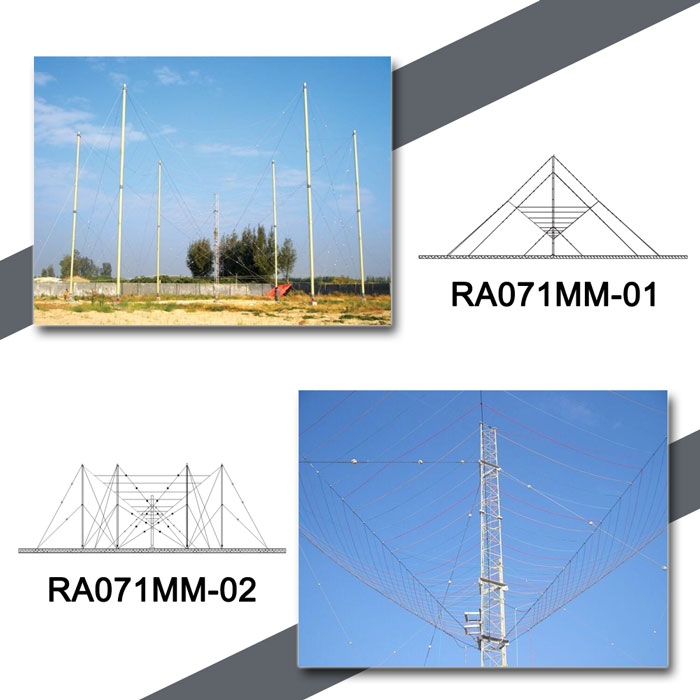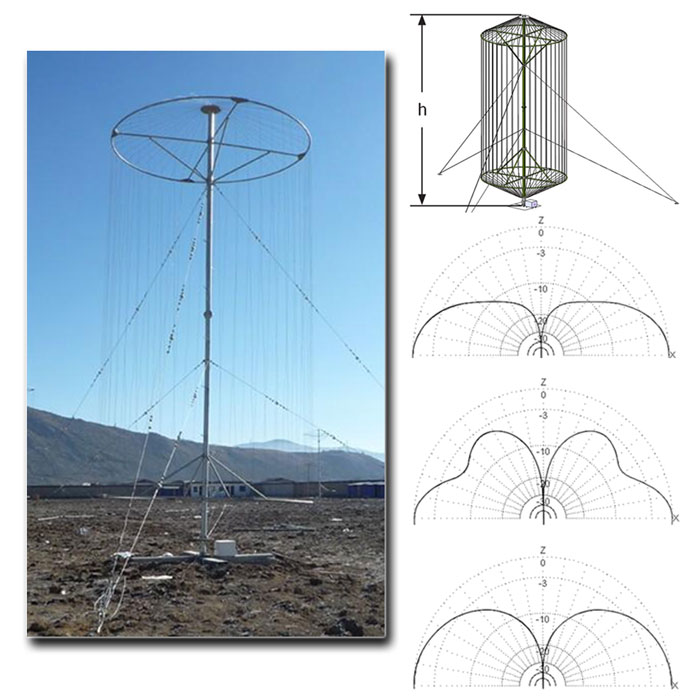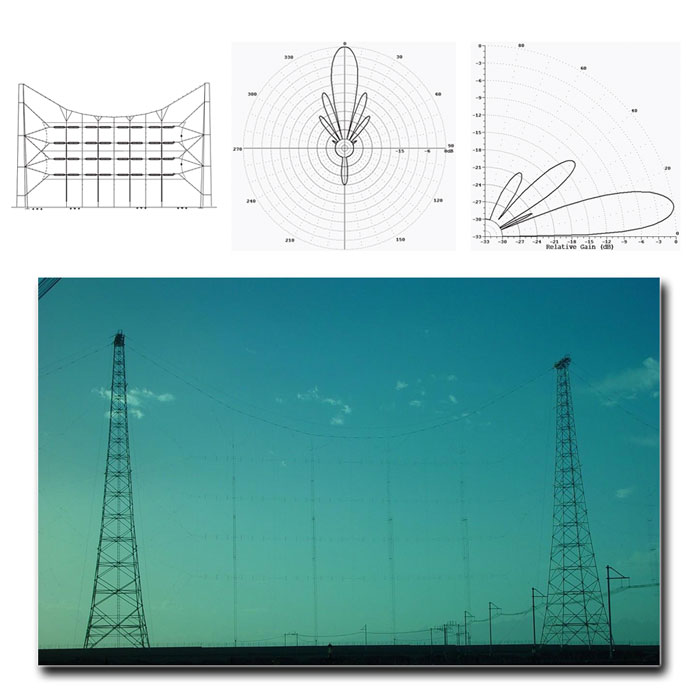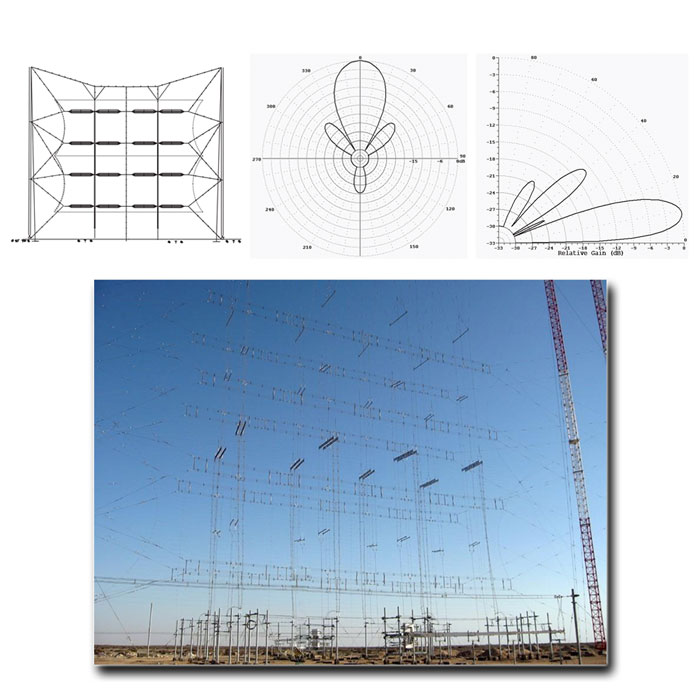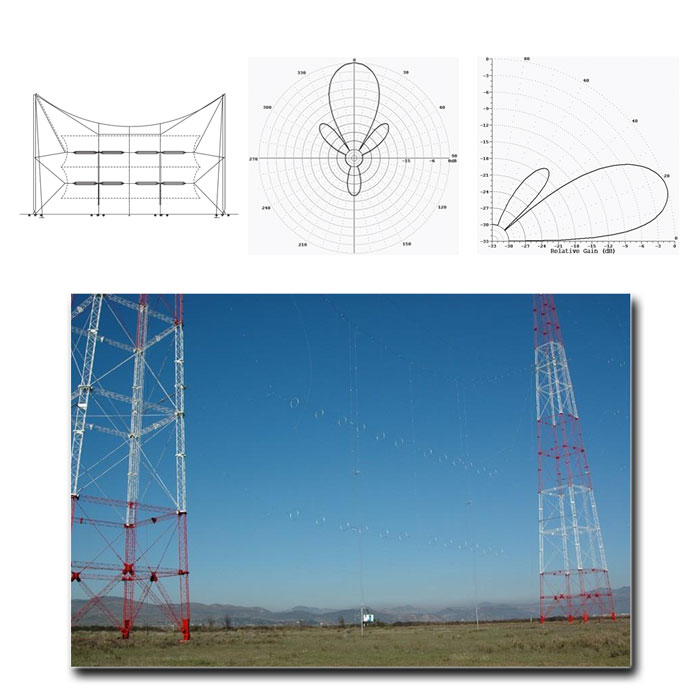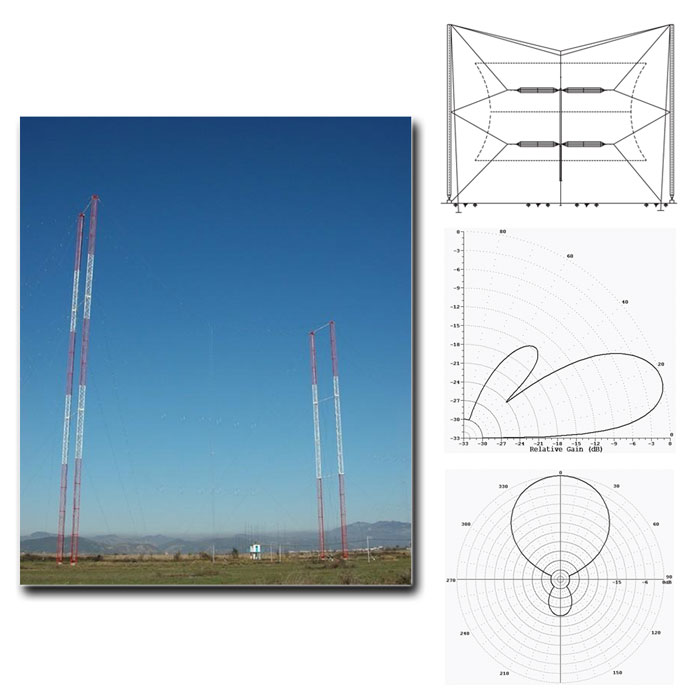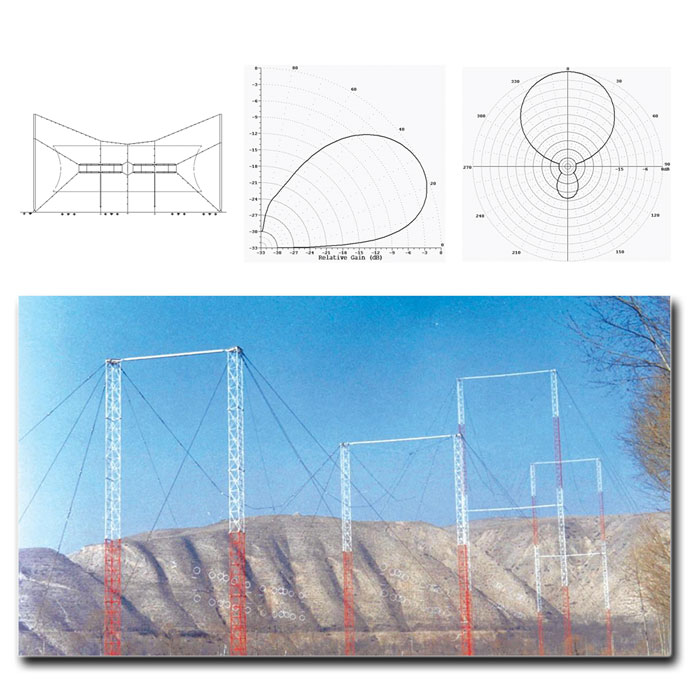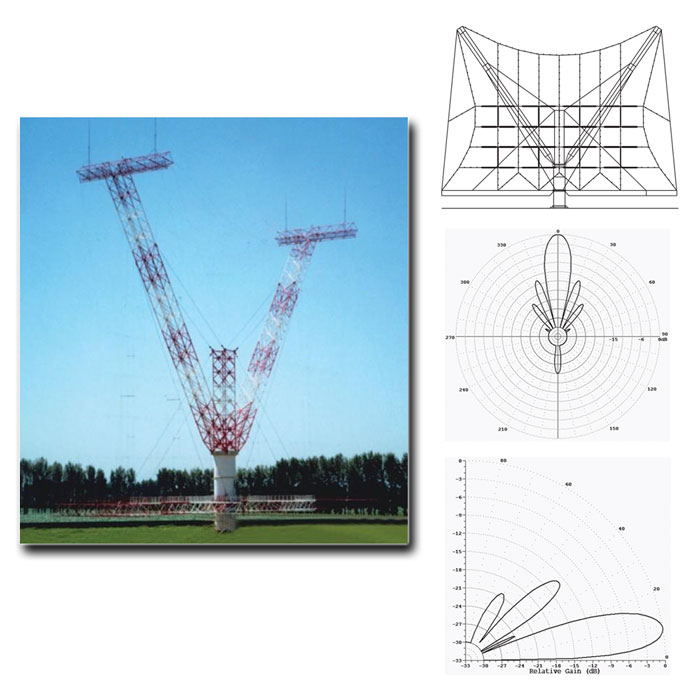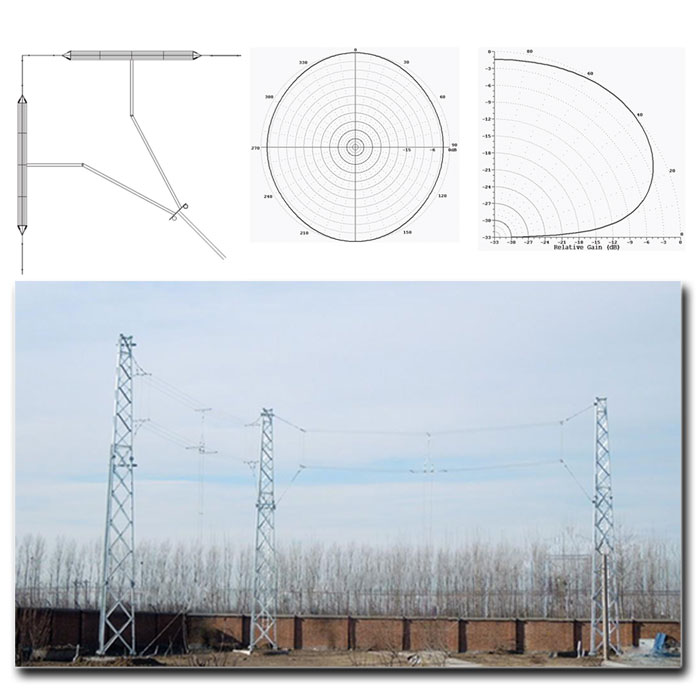
Shortwave Antenna
FMUSER’s 1.6 MHz to 30 MHz HF Shortwave Antenna for AM Station solutions are critical for industries relying on uninterrupted, long-distance communication.
1. Power Global Connections with Precision
As a leader in RF transmission technology, FMUSER specializes in designing robust, high-efficiency antennas tailored for AM broadcasting and specialized shortwave applications. This page categorizes HF shortwave antennas based on power capacity (5kW to 10kW+ systems), frequency agility, and site-specific configurations, simplifying selection for professionals targeting mission-critical broadcasts, emergency response, or cross-continent connectivity.
2. Key Features: Engineered for Excellence
- Military-Grade Durability: Weatherproof aluminum/copper construction for tropical storms, deserts, and extreme climates.
- 95%+ Signal Efficiency: Optimized impedance matching reduces signal loss for crystal-clear broadcasts.
- Dual-Polarization Support: Switch between vertical/horizontal modes to adapt to ionospheric changes.
- Certified Compliance: Meets ITU, FCC, and CE standards for global deployment.
- Scalable Solutions: From 5kW entry-level setups to 10kW+ industrial systems—ideal for hobbyists, AM radio stations, or defense networks.
3. Diverse Applications of FMUSER’s HF Shortwave Antenna
- AM Radio Broadcasting: Deploy FMUSER’s antenna to transmit AM signals across continents. Benefits: Dual-feed design boosts coverage in remote areas, while pre-tuned elements ensure minimal SWR for 24/7 broadcasting.
- Emergency & Disaster Response: Rapid-deploy antennas restore communication during crises. Benefits: FMUSER’s modular kits enable on-site assembly in <2 hours, with saltwater-resistant coatings for coastal operations.
- Military & Defense Networks: Secure HF comms for encrypted command centers. Benefits: EMP-hardened models counter electromagnetic pulses, and stealth configurations avoid detection.
- Scientific Research (Ionosphere Studies): Capture high-precision data for atmospheric research. Benefits: Wideband tuning (1.6–30 MHz) pairs with FMUSER’s analyzers for real-time signal mapping.
4. Why Choose Us: Your Trusted RF Partner
- Factory Direct Pricing: Save 30% vs. intermediaries.
- 48-Hour Global Shipping: Always in stock for 5kW/10kW systems.
- Turnkey Packages: Antennas + transmitters + installation tools.
- Pre-Configuration Services: Tested to match your site’s soil conductivity/azimuth before shipment.
- OEM Customization: Modify mast heights, element counts, or cable types.
- Proven Success: Installed in 50+ AM stations across Southeast Asia, Africa, and NATO-linked defense grids.
5. Buying Guide: Select Your Perfect Antenna
- Power Handling: Match 5kW/10kW+/15kW models to transmitter outputs.
- Frequency Range: Confirm 1.6–30 MHz coverage with ±5% tolerance.
- Site Size: Opt for compact folded dipoles (urban areas) or large rhombics (rural zones).
- Budget Flexibility: Balance cost vs. lifespan—FMUSER’s 10-year warranty outperforms competitors’ 5-year terms.
-
![FMUSER Omnidirectional Shortwave Antenna (multi-elevation&multi-feed) for AM Station]()
FMUSER Omnidirectional Shortwave Antenna (multi-elevation&multi-feed) for AM Station
Price(USD):Ask for a quotation
Sold:48
-
![FMUSER Cage Shortwave Antenna for AM Broadcast Station]()
-
![FMUSER Curtain Arrays HRS 8/4/h Shortwave Antenna for AM Transmission]()
FMUSER Curtain Arrays HRS 8/4/h Shortwave Antenna for AM Transmission
Price(USD):Ask for a quotation
Sold:27
-
![FMUSER Curtain Arrays HRS 4/4/h Shortwave Antenna for AM Station]()
FMUSER Curtain Arrays HRS 4/4/h Shortwave Antenna for AM Station
Price(USD):Ask for a quotation
Sold:74
-
![FMUSER Curtain Arrays HRS 4/2/h Shortwave Antenna for AM Broadcasting]()
FMUSER Curtain Arrays HRS 4/2/h Shortwave Antenna for AM Broadcasting
Price(USD):Ask for a quotation
Sold:69
-
![FMUSER Curtain Arrays HR 2/2/h Shortwave Antenna for AM Broadcasting]()
FMUSER Curtain Arrays HR 2/2/h Shortwave Antenna for AM Broadcasting
Price(USD):Ask for a quotation
Sold:28
-
![FMUSER Curtain Arrays HR 2/1/h Shortwave Antenna for AM Broadcasting]()
FMUSER Curtain Arrays HR 2/1/h Shortwave Antenna for AM Broadcasting
Price(USD):Ask for a quotation
Sold:67
-
![FMUSER Rotatable Curtain Arrays Shortwave Antenna for AM Broadcast Station]()
FMUSER Rotatable Curtain Arrays Shortwave Antenna for AM Broadcast Station
Price(USD):Ask for a quotation
Sold:97
-
![FMUSER Omnidirectional Quadrant Shortwave Antenna HQ 1/H for AM Broadcast Station]()
FMUSER Omnidirectional Quadrant Shortwave Antenna HQ 1/H for AM Broadcast Station
Price(USD):Ask for a quotation
Sold:51
- How many types of commercial shortwave antennas are there?
- There are several types of commercial level short wave antennas, each with its own specific characteristics and uses. Here are some of the most common types:
1. Dipole Antennas: The dipole antenna is a widely used type of antenna in shortwave broadcast and amateur radio applications. It consists of two conductive elements of equal length that are fed at the center with a transmission line. The dipole antenna is relatively easy to construct and provides good performance for its size.
2. Loop Antennas: A loop antenna is a circular or rectangular conductor that is fed at one or more points along its length. Loop antennas are directional and can provide excellent performance in certain frequency ranges.
3. Yagi Antennas: Yagi antennas, also known as beam antennas, consist of a driven element (a dipole or folded dipole) and one or more parasitic elements arranged along a boom. They are highly directional and can provide high gain and excellent performance in specific frequency ranges.
4. Log Periodic Antennas: A log periodic antenna consists of a series of dipole elements of gradually increasing length that are arranged along a support structure. They are designed to provide wide frequency coverage with relatively uniform gain and are commonly used in scientific and research applications.
5. Parabolic Antennas: A parabolic antenna consists of a curved reflector dish that is used to focus electromagnetic waves onto a smaller antenna (known as a feed). They are highly directional and can provide high gain and excellent performance in specific frequency ranges.
6. Vertical Radiators: This type of antenna consists of a single elongated element that is grounded at the base and fed with a transmission line at the top. Vertical radiators are omnidirectional and are commonly used in mobile or portable applications.
Each type of antenna is designed to provide specific performance characteristics in a particular frequency range. The choice of antenna for a shortwave station will depend on a number of factors, including available space, desired frequency coverage, and required gain. The antenna is typically installed with the help of professional antenna engineers or technicians, who will ensure that the antenna is properly matched to the transmitter and that it can handle the power output of the station.
- How many types of consumer shortwave antennas are there?
- There are several types of consumer level short wave antennas, each designed with different applications and performance characteristics. Here are some of the most common types:
1. Whip Antennas: Whip antennas are thin, flexible antennas that are typically found on portable shortwave receivers. They are omnidirectional and do not require any external support to operate. They are easy to transport and can be used both indoors and outdoors.
2. Wire Antennas: Wire antennas consist of a length of wire that is strung up between two supports, such as trees. They are easy to construct and can be highly effective when properly installed.
3. Magnetic Loop Antennas: Magnetic loop antennas use a loop of wire that is wound around a magnetic core. They are highly directional and can provide excellent performance in certain frequency ranges.
4. Vertical Antennas: Vertical antennas consist of a single elongated element that is grounded at the base and fed with a transmission line at the top. They are omnidirectional and are commonly used in mobile or portable applications.
5. Discone Antennas: Discone antennas are wideband antennas that are designed to cover a broad range of frequencies. They are typically used in amateur radio applications and are commonly found on scanner receivers.
6. Ground Plane Antennas: Ground plane antennas consist of a vertical element attached to a set of ground radials. They are highly omnidirectional and can provide good performance on a limited budget.
Each type of consumer level short wave antenna is designed to provide specific performance characteristics in a particular frequency range. The choice of antenna will depend on a number of factors, including available space, desired frequency coverage, and required gain. Consumer antennas are typically easier to install and maintain than commercial antennas and can often be assembled by the user without professional assistance.
- What are differences between commercial and consumer level short wave antenna?
- There are significant differences between commercial-level shortwave radio transmitting antennas and consumer-level shortwave radio receiving antennas:
1. Size: Commercial-level shortwave radio transmitting antennas are substantially larger than consumer-level shortwave radio receiving antennas. They are designed to handle higher power levels, require larger ground systems, and are meant for outdoor installations. Consumer-level shortwave radio receiving antennas are compact and are designed for a home or mobile installation.
2. Appearance: Commercial-level shortwave radio transmitting antennas are usually towers or large horizontal arrays with guys and beam antennas that have a distinctive appearance. Consumer-level shortwave radio receiving antennas are often a simple dipole, loop, or whip antenna with no guy wires or other visible support structures.
3. Weight: Commercial-level shortwave radio transmitting antennas are very heavy and require substantial anchoring and support structures, while consumer-level shortwave radio receiving antennas are lightweight and can be mounted on small roof or tripod masts.
4. Price: Commercial-level shortwave radio transmitting antennas are expensive due to their size, complexity, and construction materials. Consumer-level shortwave radio receiving antennas, on the other hand, are generally quite affordable.
5. Applications: Commercial-level shortwave radio transmitting antennas are used for long-range voice and data communication. Consumer-level shortwave radio receiving antennas are used for personal listening and communication and do not offer the range and power required for commercial communication.
6. Performance: Commercial shortwave radio transmitting antennas are designed to produce exceptionally high signal levels and reliable transmission over significant distances for communication and broadcasting purposes. The performance of consumer-level shortwave radio receiving antennas is focused on receiving weak signals over shorter distances for personal listening and communication purposes.
7. Structures: Commercial-level shortwave radio transmitting antennas are typically erected on large metal towers or masts that require professional installation, while consumer-level shortwave radio receiving antennas are designed for easy mounting on a smaller structure, such as a roof or tripod.
8. Frequency: Commercial-level shortwave radio transmitting antennas are designed to operate at specific frequencies, either for broadcasting or point-to-point communication. Consumer-level shortwave radio receiving antennas are typically designed to receive a wide range of frequencies.
9. Installation, repair, and maintenance: Installation, repair, and maintenance for commercial-level shortwave radio transmitting antennas are more complex than for consumer-level shortwave radio receiving antennas, often requiring specialized tools and professionals for installation, repair, and maintenance. Consumer-level shortwave radio receiving antennas are easy to install, and repair and maintenance can often be done by the user.
In summary, commercial-level shortwave radio transmitting antennas are designed for professional applications, requiring high power and long-range communication capability, and require professional maintenance. In contrast, consumer-level shortwave radio receiving antennas are affordable and designed for personal use with simple installation, repair, and maintenance requirements.
- How far can a short wave antenna cover?
- The coverage of a commercial shortwave antenna depends on several factors, including the frequency range, transmitter power output, antenna height and configuration, and atmospheric conditions. The effective transmission range of a commercial shortwave station can vary widely depending on these factors and can range from several hundred to several thousand miles.
The maximum coverage of a commercial shortwave antenna is determined by its radiation pattern, which is the directionality of the antenna's signal. Most shortwave antennas are designed to provide a more or less omni-directional coverage pattern, which means that the signal is broadcast in all directions from the antenna. However, under certain circumstances, such as when using directional antennas or in mountainous terrain, the broadcast coverage can be limited or directional.
There are several ways to improve the broadcast coverage of a commercial shortwave antenna. Here are a few common methods:
1. Increase the height of the antenna: The higher the antenna is mounted, the further its signal will reach. Increasing the height of the antenna can improve the range and coverage of the shortwave signal.
2. Use a more powerful transmitter: By increasing the power output of the transmitter, the signal strength of the broadcast can be increased, resulting in a larger coverage area.
3. Use an antenna tuner: Matching the impedance of the antenna to the transmitter can improve transfer of energy, reducing signal loss, and improving signal coverage.
4. Use a better-quality antenna: Using a high-quality antenna designed for the specific frequency range can significantly improve the signal quality and coverage area.
5. Optimize the antenna configuration: Adjusting the antenna configuration for maximum effectiveness relies on technological factors such as polarization of waves, or by adjusting the spacing of its components.
It's important to remember that any changes made to a commercial shortwave antenna system can have a significant impact on its performance and may require specialized expertise. It's always best to consult professional antenna engineers or technicians before making any modifications to a commercial shortwave antenna system.
- What are the most important specifications of a short wave antenna?
- The physical and RF specifications of a commercial shortwave antenna are important factors that determine its performance and effectiveness. Here are some of the most common physical and RF specifications of a commercial shortwave antenna:
1. Frequency Range: The frequency range specifies the range of frequencies that the antenna is designed to cover and transmit. The frequency range can range from a few kilohertz to several megahertz.
2. Input Impedance: The input impedance of a shortwave antenna specifies the level of resistance that the antenna has to the flow of electrical current. Antennas with high impedance ratings may require additional matching or tuning to tune the antenna system for efficient operation.
3. Maximum Power Handling: The maximum power handling rating specifies the amount of power that the antenna can handle without damaging its components. It is important to operate the antenna within its specified power handling range to prevent damage and ensure optimal performance.
4. Radiation Pattern: The radiation pattern of an antenna describes the directionality of its electromagnetic radiation. Different antenna types have different radiation patterns ranging from directional to non-directional.
5. Gain: Antenna gain is a measure of the amount of signal power that is delivered to the antenna by a transmitter, compared to the amount of power that would be delivered to an isotropic antenna (one that radiates equally in all directions).
6. Polarization: Antenna polarization refers to the orientation of the electric field of the radiated wave with respect to the ground plane. The three types of polarization are horizontal, vertical, and circular.
7. Material Construction: The materials used in the construction of an antenna can have an impact on its performance and durability. Typical materials include aluminum, steel, copper wire, and fiberglass.
8. Directivity: Directivity depicts the preferred direction of maximum radiation of the antenna. It is specified as a function of the azimuthal and often also elevation angles. The higher the directivity the more efficient is the propagation of signals in the target direction.
These and other specifications can impact the performance and effectiveness of a commercial shortwave antenna, and it is important to consider these factors when selecting an antenna for a particular application. Professional antenna engineers or technicians can help ensure that the specifications of an antenna are appropriate for its intended use.
- What are the structures of a short wave antenna?
- What are the structures of a commercial short wave antenna?
For short wave Dipole Antennas:
Dipole Antennas are a widely used type of antenna in shortwave broadcast and amateur radio applications. Their construction is relatively simple and requires two conductive elements of equal length that are fed at the center with a transmission line. Here are the structures of a commercial short wave Dipole Antenna:
1. Central Feed Point: A Dipole Antenna is fed at the center with a transmission line, which is usually a coaxial cable that provides electrical power from the transmitter to the antenna.
2. Conductive Elements: The two conductive elements are the two equal lengths of wire or other conductive material, such as aluminum or copper, that make up the dipole antenna. The length of the elements is determined by the frequency range of the transmitted signal and their positioning will depend on the desired radiation pattern.
3. Balun: A Balun is usually a transformer that matches the unbalanced output impedance of the coaxial cable to the balanced input impedance of the dipole elements. The Balun can also help to reduce noise and electromagnetic interference.
4. Support Structure: A Dipole Antenna is usually mounted on a support structure, which can be a metal tower or a wooden or fiberglass pole. The structure should be high enough to keep the antenna away from trees, buildings, and other obstacles that could interfere with the signal.
5. Bracing and Guy Wires: In order to support the structure and keep it stable, bracing and guy wires are often used. Guy wires are tensioned cables that anchor the antenna structure firmly to the ground.
6. Insulators: Insulators are used to prevent the conductive elements from touching one another and shorting out the antenna. Insulators can be made of a variety of materials and can take many forms.
The Dipole Antenna is a simple and effective antenna design that is widely used in shortwave broadcast and amateur radio applications. It is a relatively low-cost option that provides medium to high gain in a variety of frequency ranges, depending on its length. Dipole Antennas can be customized for different applications, including horizontal, vertical, or sloping orientations, and can be installed by professional antenna engineers or technicians.
For short wave Loop Antennas:
Commercial shortwave loop antennas typically consist of a loop of wire that is connected to a tuning capacitor. The loop may be circular, square, or rectangular in shape, and is often made of copper or aluminum tubing or wire. The tuning capacitor is used to adjust the resonance of the antenna, allowing it to be tuned to different frequencies. The capacitor may be a variable or fixed capacitor, and is often located in a weatherproof enclosure along with the loop. Some loop antennas also include an amplifier to boost the signal strength. The entire assembly may be mounted on a pedestal or mast, and some commercial loop antennas may also include a rotator to allow for directional tuning.
For short wave Yagi Antennas:
Commercial shortwave Yagi antennas typically consist of a center-driven dipole element and several parasitic elements that are arranged along a common boom. The dipole element is fed with a coaxial cable, and is typically oriented parallel to the boom. The parasitic elements are made of metal rods or tubes and are smaller than the dipole element. They are spaced at precise intervals along the boom and are connected to the feedline through a system of matching networks and directors. The directors are placed in front of the dipole element and function to increase the gain and directivity in the forward direction. The reflector element is located behind the dipole and helps to reflect and focus the signal in the forward direction. The entire assembly is typically mounted on a mast or tower and may include a rotor or other directional control mechanism. Commercial Yagi antennas may also include additional features such as adjustable elements for more precise tuning, weatherproofing, and corrosion-resistant materials for extended durability.
For short wave Log Periodic Antennas:
Commercial shortwave Log Periodic antennas typically consist of a series of driven elements and reflector elements that are arranged in a geometric pattern along a boom. The elements are made of metal rods or tubes and are progressively longer toward one end of the boom, with the shortest element closest to the feed point. The distance between adjacent elements and the length of each element are designed to allow the antenna to operate over a wide range of frequencies. The elements are typically fed with a coaxial cable that runs along the boom and connects to baluns or power dividers that split the signal between the elements. The reflector elements are located at the end of the boom opposite the feed point and function to reflect and focus the signal in the forward direction. The entire assembly is typically mounted on a mast or tower and may include a rotor or other directional control mechanism. Commercial Log Periodic antennas may also include additional features such as adjustable elements for more precise tuning, weatherproofing, and corrosion-resistant materials for extended durability.
For short wave Parabolic Antennas:
Commercial shortwave parabolic antennas consist of a large, curved dish made of metal or fiberglass that is shaped like a parabola. The curved surface of the dish is covered with a fine mesh or reflective coating. At the center of the dish is a small, feed horn or dipole antenna that is connected to the transmitter or receiver with a waveguide or coaxial cable. The feed horn is located at the focal point of the parabolic reflector and is designed to direct the radio waves in a narrow beam. The size of the dish determines the directionality and gain of the antenna. Larger dishes provide greater gain and directionality, but are more difficult to install and maintain. The entire assembly is typically mounted on a mast or tower and may include a rotor or other directional control mechanism. Commercial parabolic antennas may also include additional features such as adjustable elements for more precise tuning, weatherproofing, and corrosion-resistant materials for extended durability.
For short wave Vertical Radiators:
Commercial shortwave vertical radiators typically consist of a single, tall, vertical wire or multiple wires arranged in a straight line. The wire(s) are typically made of copper or aluminum and can vary greatly in length depending on the frequency of operation. A coaxial cable is connected to the base of the radiator and is used to feed the signal to the antenna. A ground plane consisting of several wires or rods, or a network of buried radials, may be installed beneath the radiator to improve the antenna's efficiency. The ground plane enhances the radiation pattern of the antenna and helps to reduce interference from nearby structures. The entire assembly is typically mounted on a mast or tower and may include a rotor or other directional control mechanism. Commercial vertical radiators may also include additional features such as adjustable elements for more precise tuning, weatherproofing, and corrosion-resistant materials for extended durability.
- Is short wave antenna equals to AM broadcast antenna and why?
- Commercial shortwave antennas are not the same as AM broadcast antennas, although both types of antennas are used for transmitting and receiving radio signals in the longwave and shortwave frequency bands. The main difference between these two types of antennas is their operating frequency range and the way in which the radio waves are propagated.
Commercial shortwave antennas are designed to operate in the shortwave frequency range, typically from about 1.8 MHz to 30 MHz. These antennas are used primarily for long-distance communication over thousands of miles. The radio waves used in shortwave communication are refracted by the Earth's ionosphere, which allows them to travel great distances without being absorbed by the atmosphere.
On the other hand, AM broadcast antennas are designed to operate in the mediumwave frequency range, typically from about 540 kHz to 1600 kHz. These antennas are used primarily for local and regional broadcasting. Unlike shortwave radio waves, which are refracted by the ionosphere, AM broadcast radio waves are ground waves that propagate over the surface of the Earth. AM broadcast antennas are typically much shorter than shortwave antennas and are designed to radiate the signal out in all directions, rather than being highly directional like shortwave antennas.
So while there may be some similarities in the physical design of these antennas, they are not equal in terms of their intended use, operating frequency range, and propagation characteristics.
- What consists of a complete short wave antenna system?
- A complete commercial shortwave antenna system typically includes the following equipment:
1. Antenna structure - Tower, mast, or supporting structure for the antenna.
2. Antenna - Depending on the desired frequency range, it could be a loop, Yagi, Log Periodic, or Parabolic antenna.
3. Transmission line - A coaxial or waveguide cable to carry the radio frequency signal from the transmitter to the antenna.
4. Baluns - A balun (balanced-unbalanced transformer) is used to match the impedance (resistance to the flow of electrical energy) of the transmission line to the impedance of the antenna.
5. Feedline surge protection - To protect the transmission line from voltage surges that can be caused by static, lightning, or other sources.
6. Tuning equipment - Including a tuner, preselector, or filter to adjust the resonance of the antenna and to minimize interferences from other stations.
7. Power amplifiers - Used to amplify the low-level radio frequency signal from the transmitter to the level required for the antenna.
8. Transmitter - The equipment that generates and amplifies the radio frequency signal.
9. Controller – To monitor and control the operation of the antenna and transmitter.
10. Grounding equipment - To provide a safe and effective path to ground for the antenna system to protect against damage caused by static discharge and lightning strikes.
11. Antenna monitoring equipment - For verifying proper antenna operation and troubleshooting signal problems.
12. Test equipment - Including an SWR meter, power meter, spectrum analyzer, and other test equipment for measuring and testing the characteristics of the antenna system.
13. Remote control equipment - For remote control of the system from a remote location.
Overall, the exact equipment needed for a complete commercial shortwave antenna system will depend on the specific requirements of the station and the desired frequency range. The system can be configured in various ways depending on the needs and circumstances of the installation.
- What are differences between transmission and reception type of short wave antenna?
- There are several differences between commercial shortwave radio transmitting antennas and receiving antennas:
1. Size: Transmitting antennas are generally larger in size compared to receiving antennas. This is because they need to produce and radiate a higher amount of electromagnetic energy to propagate the signal over long distances.
2. Appearance: Transmitting antennas may be more visible due to their larger size and height. Receiving antennas are often smaller and can be concealed or disguised as part of the building or structure.
3. Weight: Transmitting antennas are generally heavier due to the materials used to withstand high wind loads, ice and snow accumulation, and lightning protection. Receiving antennas are much lighter and often made of materials such as wire or lightweight aluminum.
4. Price: Transmitting antennas are generally more expensive compared to receiving antennas due to their larger size, complexity, and construction materials.
5. Applications: Transmitting antennas are used for broadcasting, telecommunications, and emergency communications. Receiving antennas are used for monitoring radio transmissions, hobbyist listening, and other applications where receiving signals is the primary objective.
6. Performance: Transmitting antennas have a higher power output, which allows them to transmit signals over a longer distance. Receiving antennas have a higher sensitivity, which allows them to pick up weaker signals that are further away.
7. Structures: Transmitting antennas can be mounted on towers, poles, or other structures designed to support their weight and withstand high wind loads. Receiving antennas can be mounted on a variety of structures, such as buildings, trees, or even portable sets.
8. Frequency: Transmitting antennas are designed to transmit signals at specific frequencies allocated for broadcasting or telecommunication services. Receiving antennas are designed to receive signals across a range of frequencies.
9. Installation, repair, and maintenance: The installation of transmitting antennas is more extensive, involving construction, permits, electrical work, and various inspections. Maintenance involves high-risk activities such as tower climbing, electrical work, and radio frequency safety protocols. Receiving antennas are less involved in these areas and can often be installed, repaired, and maintained by the user.
Overall, transmitting antennas are much larger, heavier, and more expensive than receiving antennas. They are designed to transmit signals over long distances for broadcasting, telecommunications, and emergency communications. On the other hand, receiving antennas are smaller, lighter, and more affordable, used for monitoring radio transmissions, hobbyist listening, and other applications where receiving signals is the primary goal.
- Why a high quality short wave antenna is important for a short wave radio station?
- A high-quality commercial shortwave antenna is essential for a commercial shortwave radio station because it is the primary means of propagating the radio signals over long distances. The quality of the radio antenna affects the station's signal strength, range, and clarity, which directly impacts the station's success.
Here are some reasons why a high-quality commercial shortwave antenna is important for a commercial shortwave radio station:
1. Signal strength: A high-quality antenna is designed to efficiently transmit or receive radio signals, resulting in a stronger signal. Without a strong signal, the radio station's audience will decrease since the signal will not be clearly heard by listeners.
2. Range: High-quality antennas are designed for long distance propagation of radio signals. A good antenna can reach farther distances without the need for additional transmitter power which can lead to increased costs and regulatory difficulties, it is very important to maximize the range that is enabled by the use of a high-quality antenna.
3. Clarity: A high-quality antenna can minimize signal distortion, noise, and other types of interference that affect the clarity of the signal. This is essential for improving the listening experience of the audience. For a radio station, clarity is one of the most important factors for retaining audience and building reputation.
4. Cost effectiveness: A high-quality antenna can save costs by reducing the need for additional transmitter power, which can consume more electricity and result in regulatory problems. Compared to other equipment required by a radio station, the cost of a high-quality antenna is often relatively low.
In conclusion, a high-quality commercial shortwave antenna is an essential component of any commercial shortwave radio station. It is critical for ensuring optimal signal strength, range, and clarity, which are vital for the success of the station. Investing in a quality antenna is a wise investment for a radio station, as it can improve the listening experience for the audience and reduce operational costs.
- How to choose the best short wave antenna?
- 1. Expected frequency range: The frequency range of the commercial shortwave antenna should be compatible with the frequency range of the radio station's transmitter. Different commercial shortwave antennas have different frequency ranges, so it's important to choose an antenna that covers the frequency range of the frequencies you intend to transmit or receive. Some antennas may have a narrow bandwidth, whereas others may be capable of covering a broad frequency range.
2. Power handling capabilities: The power handling capabilities of the antenna must be able to handle the output power of the transmitter. If the transmitter has a high power output, choose an antenna with a higher power handling rating to match.
3. Radiation patterns: The radiation pattern of the antenna determines the direction in which the signal radiation is strongest. When selecting an antenna, consider the desired coverage area and direction of signal transmission of the radio station. For a commercial shortwave radio station, a directional antenna with a narrow radiation pattern is more suitable to ensure better signal strength and clarity. Choose an antenna that has a radiation pattern that suits your coverage needs. Some antennas produce an omni-directional pattern, while others produce directional patterns or coverage zones directed toward predetermined areas.
4. Efficiency: Choose an antenna with high efficiency to ensure that the transmitter's output power is efficiently transmitted as electromagnetic waves.
5. Antenna gain and directivity: Antenna gain is a measure of how well the antenna can transmit or receive a signal. Directivity determines in which direction the antenna sends or receives its maximum signal. Selecting an antenna with higher gain and directivity helps optimize signal strength and reduce interference.
6. Size: The size of the antenna should be in proportion to the wavelength of the radio signal to ensure maximum efficiency.
7. Durability: Shortwave antennas are exposed to harsh weather conditions and have to withstand strong winds, storms, and sunlight. Choose an antenna with high durability and resistance to corrosion.
8. Cost: The cost of the antenna is an important factor to consider. Research and evaluate different models and brands to find the best option that fits within the station's budget.
9. Antenna height: The height of the antenna is important for optimal signal transmission, especially for long-range coverage. As a general rule, a higher antenna height results in a larger coverage area. Taller antennas generally provide better coverage and range. The antenna should be mounted as high above the ground as possible.
10. Tower and support structure: The antenna tower and supporting structures should be of sufficient height, strength, and stability to support the antenna. In addition, a high-quality grounding system is necessary for optimal performance and safety.
11. Feedline: The feedline, or cable that connects the antenna to the transmitter, plays an important role in transmitting the signal without suffering from low loss. The type and quality of the feedline can affect signal strength and quality.
12. Tuning and maintenance: Ensure that the antenna system is properly tuned and maintained for optimal performance.
- What certificates are needed for short wave antenna system buildup?
- The specific regulatory requirements and certification process for setting up a commercial shortwave antenna system for a commercial shortwave station vary by country or region. However, there may be a number of certificates and permits that you may need to obtain before installing and operating a shortwave antenna system, including:
1. Radio Broadcasting License: In most countries, you will need to obtain a license to operate a commercial shortwave station from your local regulatory authority. To obtain this license, you may need to comply with a range of technical, financial and regulatory requirements.
2. Frequency Allocation Certificate: Depending on your frequency band and the country or region where you intend to operate, you may need a frequency allocation certificate or a spectrum usage license to operate a commercial shortwave radio station.
3. Building and Planning Permits: You may need to obtain permits from local authorities in order to build or install a transmission site or antenna.
4. Environmental Impact Assessment: In some cases, you may be required to do an environmental impact assessment before installing a commercial shortwave antenna system.
5. Technical Certification: You may need to obtain technical certification from a competent authority that your antenna system meets the required international technical standards for shortwave radio broadcasting.
6. Safety Certifications: You may need to obtain safety certifications for your antenna system to make sure it complies with local regulations and safety standards.
It is important to consult with your local regulatory authority and industry experts before beginning construction of a shortwave antenna system for a commercial shortwave station to ensure that you are in compliance with all relevant legal requirements and safety standards.
- What is the full process of a shortwave antenna from production to installation?
- Here is a general outline of the process for producing and installing a commercial shortwave antenna for a commercial shortwave station, although the specific details may vary depending on the manufacturer and project requirements:
1. Design: The antenna manufacturer will work with the customer to design an antenna system that meets the station's power, frequency, radiation pattern, and coverage requirements. This involves analyzing the surrounding terrain, vegetation, and other factors that may affect the radio signal.
2. Production: The antenna is manufactured according to the design specifications. This may involve constructing the antenna elements, reflectors, and support structures, and coating them with protective materials to withstand the elements and ensure optimal performance.
3. Quality Control: The antenna is tested and inspected to ensure that it meets the required technical specifications and quality standards. This involves conducting a range of tests to verify the radiation pattern, frequency response, impedance matching, and other performance indicators.
4. Shipping: The antenna is shipped to the customer's site, often in sections to allow for easier transportation.
5. Assembly and Installation: The antenna is assembled and installed at the commercial shortwave station, a detailed and specialized operation requiring trained technicians. This involves hoisting the antenna to its designated location, and then attaching it to its support structure or tower. The feedline, ground system, and other accessories are also installed and connected to the antenna.
6. Tuning and Testing: The installed antenna is tuned and tested to ensure that it is operating optimally. This process involves using specialized monitoring and testing equipment to measure the antenna's performance, including radiation pattern, impedance, and signal strength.
7. Commissioning: Once the antenna is tuned and tested, it can be commissioned for commercial use.
Assembling and installing a commercial shortwave antenna system is a complex process that requires specialized expertise and equipment. It is important to work with qualified professionals throughout the entire process to ensure that the antenna meets all regulatory requirements and operates optimally.
- How do you correctly maintain a short wave antenna?
- To maintain a commercial shortwave antenna for optimal performance, it is important to follow these basic steps:
1. Regular Inspection - Inspect the antenna for any signs of damage or wear, checking the mounting structure's base, particularly to its conductivity and stability. Check the grounding system's electrical resistance and make sure it's connected properly.
2. Clean Regularly - As needed, clean the antenna and all its components, such as the feedline and tower, with a soft-bristled brush and water. Don't use high-pressure washers or abrasive cleaners that might damage the coating or material of the antenna.
3. Repair Damages - Repair any damages to the antenna immediately to prevent further corrosion and deterioration.
4. Upgrade - Keep up-to-date with advancements in technology and updates in regulations to keep your equipment and maintenance methods up to standard.
5. Regular Testing - Conduct regular tests of the antenna to ensure that it is functioning properly and still meets the required technical specifications. This may involve using specialized equipment to test the radiation pattern, impedance, and signal strength of the antenna.
6. Maintain Good Grounding - The grounding system is an essential component of the antenna system, ensuring protection of equipment and people from electrical discharges, so it's important to maintain proper grounding at all times.
7. Proper Lubrication - Keep moving parts, such as clamps, connectors, and hinges, lubricated with non-conductive lubricants to prevent sticking, rusting, or seizing up over time.
By following these guidelines, you can maintain a commercial shortwave antenna system for optimal performance and reliability. Don't hesitate to engage the help of qualified professionals to address more complex maintenance issues or ensure if you are in compliance with any regulatory requirements.
- How do you repair a short wave antenna if it fails to work?
- Repairing a commercial shortwave antenna can be a complex process that requires specialized knowledge and equipment. If your commercial shortwave antenna system fails to work, here are some steps you can take to determine the problem:
1. Collect information - Before any repair, gather as much information as possible to determine the root causes of the issue. This can include reviewing test results, maintenance records/logs, local weather records, and other relevant data sources.
2. Inspection - If the cause of the failure is not immediately apparent, closely inspect the antenna and associated equipment for any signs of damage, corrosion, or wear and tear. Check grounding cables and associated infrastructure to ensure they aren't damaged.
3. Diagnostic testing - Use specialized testing equipment to further diagnose any problems, including antenna analyzers, elemental meters, probes, and other tools to test individual components of the antenna system.
4. Locate the cause of issues - Once the issue has been diagnosed, locate the source of the problem(s). Repair or replace any faulty or failing components, including damaged antenna elements, feedline, or connectors.
5. Re-testing and adjustment - Once repairs are made, test the antenna again to ensure that it is functioning properly. Adjust the tuning to ensure the optimal performance of the antenna.
6. Environmental factors - Consider the environment around the antenna and identify any factors that may have contributed to the failure of the antenna. Update any protection mechanisms against high winds or excessive rain or humidity by conceivably installing additional protection for equipment.
It is important to consult with qualified professionals if you are not sure how to make repairs, and always take appropriate safety precautions when working on a commercial shortwave antenna system. Regular maintenance and inspection of your antenna system can prevent these kinds of issues.
- What qualifications of an engineer are needed for short wave antenna system buildup?
- The specific qualifications required to set up a complete commercial shortwave antenna system for a commercial shortwave station will depend on your country's laws and requirements. Generally speaking, you may need to meet certain technical and regulatory criteria to obtain the necessary permits and licenses to operate a commercial shortwave station and its antenna system. Specific qualifications that may be required include:
1. Technical Education: A degree or diploma in electronics, telecommunications, electrical engineering, or a related field can provide the necessary technical background to design, install, and operate a commercial shortwave antenna system.
2. Certification in Broadcast and Telecommunications: Professional certification programs in broadcasting and telecommunications can provide specialized training and certification in the field of radio broadcast engineering, including antenna design, installation, and maintenance.
3. Licensing: To operate a commercial shortwave station in most countries, you will need to obtain a broadcasting license from the relevant regulatory authority. This license may require specific training or educational requirements.
4. Industry Experience: Experience working in the broadcast, telecommunications, or related field can be important for understanding the technical, regulatory, and operational challenges of setting up a commercial shortwave antenna system.
5. Legal Expertise: Familiarity with local regulations, laws, and standards is essential for understanding the legal and regulatory requirements for setting up a commercial shortwave antenna system.
It is essential to consult with experts in the field and the appropriate regulatory authorities for guidelines on how to proceed to plan and construct a commercial shortwave antenna system. You may also need to work with specialized contractors and service technicians who can handle specific aspects of the project, such as tower construction, grounding system installation, or equipment installation to ensure a successful project outcome.
- How are you?
- I am fine
CONTACT US


FMUSER INTERNATIONAL GROUP LIMITED.
We are always providing our customers with reliable products and considerate services.
If you would like to keep touch with us directly, please go to contact us
